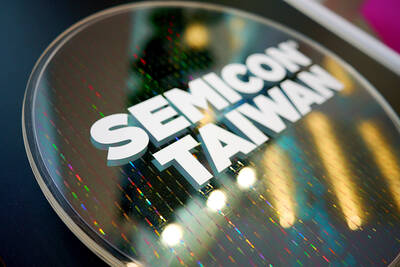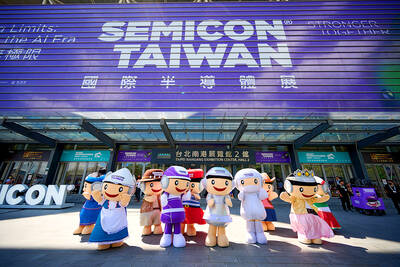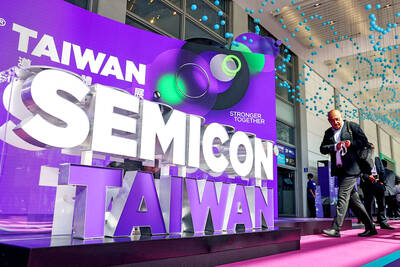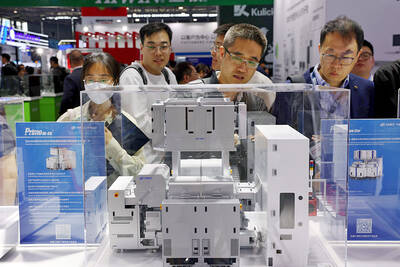The nation’s machine tool exports rose 4.4 percent annually in the period from January through last month, a surge driven by growing demand for such exports in Europe, China and the US, the latest industrial data showed.
Taiwan’s total machine tool exports climbed to US$2.14 billion over the seven-month period from US$2.05 billion a year ago, according to data compiled by the Taiwan Machine Tool & Accessory Builders’ Association.
The group maintained its forecast that local machine tool exports this year would rise by between 10 and 20 percent compared with the previous year, association secretary-general Carl Huang (黃建中) said via telephone yesterday.
“Machine tool exports are set to post a larger annual increase in the second half of the year than in the first, given that market sentiment is still strengthening,” he added.
Machine tool exports to 15 countries in Europe, which accounted for about 20 percent of Taiwan’s total machine tool exports, rose 20.7 percent in the first seven months of the year, Huang said.
Huang said the political tension resulting from the Ukraine crisis has affected market sentiment in the region, posing uncertainties for machine tool exports growth in the area this year since many buyers continue to adopt a wait-and-see stance as the situation unfolds.
Shipments to China, which accounted for 34.9 percent of Taiwan’s total machine tool exports between January and last month, increased 4.5 percent to US$746.41 million, up from US$714.17 million the previous year, according to the data.
Huang said that although the Chinese government is implementing a stimulus plan to boost its economy, the pace of recovery is slower than the association expected.
Exports to the US, which accounted for 11.1 percent of total Taiwanese machine tool exports over the past seven months, saw a 5.2 percent rise to US$236.66 million from US$224.95 million the previous year.
Although the US is the most volatile of export destinations for Taiwan-made machine tools in terms of monthly growth, the association is optimistic that shipments to the US will increase annually for the whole of the year due to the economic recovery, Huang said.
Political unrest in Thailand, which accounted for 4.9 percent of Taiwan’s total machine tool exports in the first seven months, saw shipments to the Southeast Asian country decline the most, dropping 24.6 percent to US$105.23 million from US$139.57 million in January through July last year, Huang said.
Last month, total machine tool exports plunged 7.2 percent to US$326.76 million from US$352.15 million a month ago because most European countries have summer holidays in July and August, Huang said, adding that total exports are likely to remain low this month.
Exports last month were 1.6 percent higher than the US$321.71 million seen in that month the previous year, the data showed.

With this year’s Semicon Taiwan trade show set to kick off on Wednesday, market attention has turned to the mass production of advanced packaging technologies and capacity expansion in Taiwan and the US. With traditional scaling reaching physical limits, heterogeneous integration and packaging technologies have emerged as key solutions. Surging demand for artificial intelligence (AI), high-performance computing (HPC) and high-bandwidth memory (HBM) chips has put technologies such as chip-on-wafer-on-substrate (CoWoS), integrated fan-out (InFO), system on integrated chips (SoIC), 3D IC and fan-out panel-level packaging (FOPLP) at the center of semiconductor innovation, making them a major focus at this year’s trade show, according

DEBUT: The trade show is to feature 17 national pavilions, a new high for the event, including from Canada, Costa Rica, Lithuania, Sweden and Vietnam for the first time The Semicon Taiwan trade show, which opens on Wednesday, is expected to see a new high in the number of exhibitors and visitors from around the world, said its organizer, SEMI, which has described the annual event as the “Olympics of the semiconductor industry.” SEMI, which represents companies in the electronics manufacturing and design supply chain, and touts the annual exhibition as the most influential semiconductor trade show in the world, said more than 1,200 enterprises from 56 countries are to showcase their innovations across more than 4,100 booths, and that the event could attract 100,000 visitors. This year’s event features 17

Germany is to establish its first-ever national pavilion at Semicon Taiwan, which starts tomorrow in Taipei, as the country looks to raise its profile and deepen semiconductor ties with Taiwan as global chip demand accelerates. Martin Mayer, a semiconductor investment expert at Germany Trade & Invest (GTAI), Germany’s international economic promotion agency, said before leaving for Taiwan that the nation is a crucial partner in developing Germany’s semiconductor ecosystem. Germany’s debut at the international semiconductor exhibition in Taipei aims to “show presence” and signal its commitment to semiconductors, while building trust with Taiwanese companies, government and industry associations, he said. “The best outcome

Semiconductor equipment billings in Taiwan are expected to double this year, as manufacturers in the industry are keen to expand production to meet strong global demand for artificial intelligence applications, according to SEMI, which represents companies in the electronics manufacturing and design supply chain. Speaking at a news conference before the opening of Semicon Taiwan trade show tomorrow, SEMI director of industry research and statistics Clark Tseng (曾瑞榆) said semiconductor equipment billings in Taiwan are expected to grow by an annual 100 percent this year, beating an earlier estimate of 70 percent growth. He said that Taiwan received a boost from a